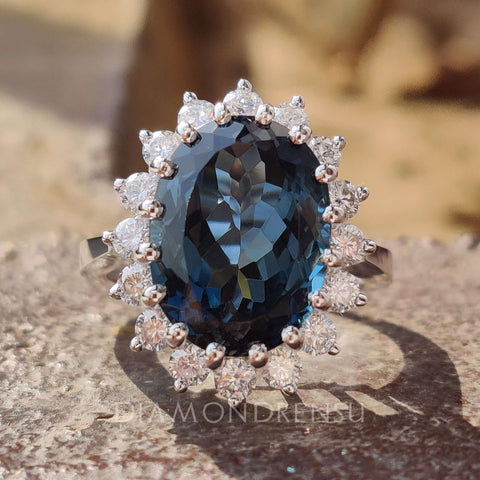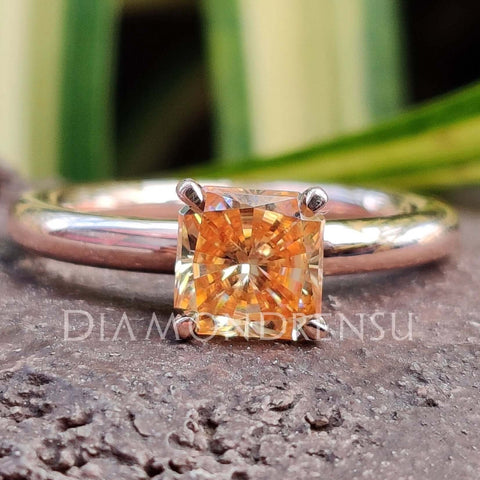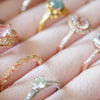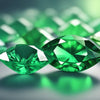
Which Finger Does a Wedding Ring Go On: A Clear Guide
The tradition of wearing a wedding ring holds strong cultural significance in various societies across the globe. One of the most common questions that arises when it comes to wedding rings is which finger to wear it on. This can be influenced by various factors, such as cultural customs, religious beliefs, and personal preferences. It's essential to understand the various meanings and significance behind each finger before making an informed decision.
Shop Fine Rings Today – Brilliant Look, Budget-Friendly Price!
In many Western countries, the wedding ring is typically worn on the left hand's ring finger. This practice is often attributed to the ancient Romans' belief that the "vena amoris," a vein running directly from this finger to the heart, symbolized a connection to love. As a result, placing the wedding ring on this finger came to be seen as a representation of love and fidelity between married couples.
However, this tradition doesn't hold true for every culture and country. In some Eastern European countries, South America, and India, the wedding ring is commonly worn on the right hand's ring finger. While the choice of which finger to wear a wedding ring on ultimately comes down to personal preference and cultural background, it's important to be aware of these diverse customs when planning your own wedding or attending a ceremony for a different culture.
Understanding Wedding Rings

Wedding rings are a significant symbol of love and commitment, representing the union of two individuals in a marriage. These rings are often worn on the ring finger, which has a rich history and tradition behind it. In many cultures, it is believed that the ring finger is directly connected to the heart, further solidifying the connection between the ring and the concept of love.
Wearing a wedding ring on the ring finger symbolizes a commitment to the partner for a lifetime. No matter the design or style, wedding rings such as Diamondrensu Designer Moissanite Wedding Bands are worn to signify a promise of love, support, and togetherness between the couple. They serve as a reminder of the vows and promises made during the wedding ceremony and are often cherished for years to come.
In addition to their emotional significance, wedding rings also possess a cultural and historical aspect. The tradition of wearing a ring as a symbol of love and commitment dates back thousands of years, and different cultures have developed their own unique interpretations of the gesture. This cultural diversity in ring-wearing traditions has led to a myriad of wedding ring designs, each expressing the couple's unique love story and their respective backgrounds.
To sum up, wedding rings play an essential role in symbolizing the love and commitment between a couple. From the ring finger's historical significance to various traditions associated with wearing a ring, these precious pieces of jewelry hold a special place in the hearts of those who wear them. Whether classic or modern, extravagant or simple, each wedding band represents the couple's everlasting love and devotion to each other.
Significance of the Fourth Finger

The tradition of wearing a wedding ring on the fourth finger of the left hand has deep cultural and historical roots. Believed to have originated from ancient Roman and Egyptian beliefs, the custom has remained popular in many cultures worldwide.
One reason for placing the wedding ring on the left ring finger has to do with the idea of the "vein of love," or the "vena amoris." Ancient Romans believed that a vein in the fourth finger of the left hand was directly connected to the heart, symbolizing the strong bond between two people in love.
Throughout history, the left-hand ring finger has been reserved for wedding rings in part due to its unique symbolism. In some cultures, wearing a ring on this finger signifies a strong emotional connection and commitment to one's partner. This practice has become so ingrained in tradition that it is now widely considered the standard across many societies.
In contemporary culture, the significance of the fourth finger is upheld by both same-sex and heterosexual couples. The custom of wearing a wedding ring on this particular finger transcends various cultures and belief systems, unifying people from various backgrounds under the notion of love and commitment. As a result, the fourth finger has become an important and symbolic element of marriage ceremonies worldwide.
In summary, the fourth finger of the left hand has historically represented a deep emotional bond and commitment in relationships, symbolized by the belief in a "vein of love." This finger has maintained its importance in many cultures, making it the customary choice for wearing wedding rings and signifying a powerful connection between two people.
Cultural Perspectives

In different cultures around the world, the tradition of wearing a wedding ring varies. This often depends on local customs and beliefs. Which hand and finger the wedding ring is worn on can vary significantly from one country to another.
- In many Western countries, such as the USA, UK, Canada, and South Africa, it is common to wear the wedding ring on the left hand's ring finger. This tradition originated from the belief that the left hand's ring finger was connected to the heart by a vein known as the "Vena Amoris" or "Vein of Love." However, this belief has been discredited by modern science.
- In many European countries, such as Germany, Austria, Netherlands, and Norway, it is customary to wear the wedding ring on the right hand's ring finger. This tradition is rooted in historical and cultural practices, such as the use of the right hand as a symbol of strength and power.
- In Greece and Turkey, wedding rings are also typically worn on the right hand's ring finger. This custom is linked to the Orthodox Christian faith, which uses the right hand during religious ceremonies and rites.
- In Russia, it is common for both men and women to wear the wedding ring on the right hand's ring finger, following the Orthodox Christian convention. However, in recent years, some liberal Russians have started wearing their wedding rings on the left hand.
- In India, wedding rings are not as universally embraced as a symbol of marriage. However, when a wedding ring is worn, it is traditionally placed on the left hand's ring finger for women and the right hand's ring finger for men. This stems from the idea that women should wear valuable objects on the left side to balance the male energy on the right side.
- In Latin American countries, such as Brazil and Colombia, cultural practices vary. In some regions, the wedding ring is worn on the right hand's ring finger, while in others, it is worn on the left hand.
- In Lebanon, it is customary to wear the wedding ring on the left hand's ring finger for both men and women. This is similar to the Western tradition and is believed to have been influenced by Western culture in the region.
Overall, the choice of which hand and finger to wear the wedding ring on varies greatly based on cultural, historical, and religious factors. Understanding the cultural context of wedding ring traditions can offer insight into a country's values and customs.
Wedding and Engagement Ring Traditions
The tradition of wearing an engagement ring dates back centuries and symbolizes the commitment between a bride and groom. The ring is typically worn on the left hand, specifically on the fourth finger, which is believed to have a vein that connects directly to the heart, symbolizing love and devotion.
In addition to engagement rings, wedding bands are also an important aspect of this tradition. These bands are often simpler in design and worn by both the bride and groom to represent their union in marriage. They are typically exchanged during the wedding ceremony when vows are said, signifying the couple's commitment to each other.
|
Tradition |
Country/Region | Customs |
|---|---|---|
| Exchange of Rings | Western Cultures | Both partners exchange rings during the wedding ceremony to symbolize their commitment. |
| Betrothal Ring | Europe (Various) | Some cultures exchange betrothal rings before the wedding, followed by the wedding ring during the ceremony. |
| Mangalsutra | India | Worn by Hindu brides, it's a black and gold beaded necklace symbolizing the marital bond. |
| Claddagh Ring | Ireland | Features a heart (love), crown (loyalty), and hands (friendship), worn to convey relationship status. |
| Double Ring Ceremony | Japan | Both partners receive a wedding ring, and the rings are worn on the left hand. |
Many couples choose diamond engagement rings for their beauty and durability, as diamonds are known to be one of the hardest and most valuable gemstones. However, there are also other options like moissanite and lab-grown diamonds, which offer similar characteristics at more affordable prices.
Some people choose to wear a promise ring before getting engaged, as a symbol of their commitment and as a precursor to an engagement ring. These rings typically have a simpler design, often without a large diamond or gemstone centerpiece.
When it comes to pairing wedding and engagement rings, there are various options. Some brides prefer to wear both rings on the same finger, stacking them together. Others may choose to wear their engagement ring on the right hand after the wedding ceremony, leaving the left ring finger reserved for the wedding band.
In conclusion, the traditions surrounding engagement and wedding rings vary across cultures and personal preferences, but the significance remains the same – representing love, commitment, and the promise of a life together.
Different Contextual Uses and Personal Preferences

There isn't a one-size-fits-all approach when it comes to choosing which finger a wedding ring should be worn on. Various factors, such as cultural practices, personal preferences, and comfort levels, must be considered. Some individuals may opt to wear a promise ring on a different finger, while others might choose to wear their wedding band solo.
In many western cultures, it has been a tradition to wear the wedding ring on the left hand's fourth finger, also known as the "ring finger." However, people from different national, cultural, and religious backgrounds may have distinct practices and beliefs. For instance, some Eastern European and South American cultures prefer wearing the wedding ring on the right hand.
Personal preferences and comfort play a significant role in determining which finger the wedding ring is worn on. Some individuals might prefer a snug fit, while others might choose a looser one for added comfort. Ultimately, the decision on which finger and hand to wear the wedding ring comes down to individual taste and the significance they attribute to the ring.
It's essential to recognize and respect the diversity in wedding ring customs among same-sex couples and LGBTQ+ individuals. In same-sex marriages, the choice of finger and hand for the wedding ring might be influenced by various factors unique to the couple's circumstances, personal preferences, and comfort levels. There is no strict "rule" regarding which finger or hand these rings should be worn on, and the decision ultimately lies with the couple.
By acknowledging the diverse contextual uses and personal preferences associated with wedding rings, it becomes clear that there isn't a single answer or norm that applies to everyone. Whether it's based on cultural traditions, personal sentiments, or comfort, the choice of which finger to wear a wedding ring will always be a deeply personal one.
Historical Implications and Folklore

The tradition of wearing a wedding ring on a specific finger has its roots in ancient civilizations. In Ancient Egypt, people believed that the vein in the fourth finger of the left hand, known as the 'Vena Amoris' or 'Vein of Love', was directly connected to the heart. This idea later spread to the Ancient Romans, who also embraced the custom of placing the wedding ring on the left hand's fourth finger.
During the early days of Christianity, the Orthodox Christian tradition introduced some variations, with the wedding ring worn on the third finger of the right hand to symbolize the Holy Trinity: the Father, the Son, and the Holy Spirit. In contrast, Jewish tradition often places the wedding ring on the index finger during the marriage ceremony.
Superstitions and folklore have also played an essential role in wedding ring placement throughout history. Some cultures believed that wearing the wedding ring on a specific finger would ward off bad luck or protect the wearer from evil spirits. Additionally, certain societies had superstitions about removing the wedding ring after the marriage ceremony, associating it with potential misfortune or the weakening of the bond between the couple.
In conclusion, the placement of the wedding ring on a particular finger varies based on cultural, religious, and historical factors. From the ancient Egyptians to the Romans and diverse religious traditions, the belief in the symbolic significance of a specific finger for wedding rings has evolved over time. Today, the left hand's fourth finger remains the most common placement globally, but variations continue to exist, showcasing the rich and diverse history surrounding this enduring symbol of love and commitment.
Material and Design Choices
| Material | Design | Description |
|---|---|---|
| Platinum | Solitaire | Classic, timeless design featuring a single diamond in a platinum setting. |
| Gold | Halo | A central diamond surrounded by a "halo" of smaller diamonds or gemstones. |
| White Gold | Vintage | Inspired by antique styles, often with intricate detailing and filigree work. |
| Rose Gold | Three-Stone | Features three gemstones, symbolizing the past, present, and future of the relationship. |
| Yellow Gold | Emerald Cut | Rectangular-shaped diamond with cut corners for a sophisticated, elegant look. |
When choosing a wedding ring, several aspects need to be considered, such as the material and design of the ring. Common materials for wedding rings include gold, silver, platinum, and titanium. Other options such as gemstones and diamonds can also enhance the beauty and significance of the ring.
Gold is a traditional choice for wedding rings, known for its timeless appeal and durability. However, platinum has gained popularity in recent years due to its hypoallergenic properties and resistance to tarnish. In terms of design, plain bands are a classic choice, while others opt for more intricate patterns or include gemstones such as cushion-cut moissanite engagement rings for added elegance.
The type of metal can also dictate the overall design of the ring. For instance, yellow gold is more suitable for a vintage look, while white gold or platinum offer a modern appeal. Adding gemstones or diamonds can further enhance the design, with various cuts and shapes to choose from, like oval moissanite engagement rings or pear-cut moissanite engagement rings for a unique touch.
When selecting the design, it is essential to consider the personal style and preferences of the individual wearing the ring. Couples can consult with a jeweler to assist in finding the perfect design that suits their taste and budget. Ultimately, the choice of material and design should reflect the commitment and love shared between the couple, creating a lasting symbol of their union.
Symbolism and Meaning
A wedding ring holds profound symbolic meaning as it represents the eternal love and commitment between two people. The circular shape of the ring symbolizes eternity, with no beginning or end, reflecting the everlasting nature of the marital bond. Additionally, the ring finger, on which the wedding ring is traditionally worn, is believed to have direct connections to the heart, further emphasizing the deep emotional bond shared by the married couple.
The heart has long been a symbol of love and affection, and its association with the wedding ring's placement amplifies the significance of this meaningful accessory. The tradition of wearing a wedding ring on the fourth finger of the left hand derives from the ancient belief that a vein in this finger, called the "vena amoris," directly connected to the heart. Though modern science has disproven this belief, the romantic symbolism of the ring finger remains firmly entrenched in contemporary wedding customs.
The union of two individuals in marriage is not only a physical and emotional joining but also a spiritual one. In many religious and cultural ceremonies, the exchange of wedding rings signifies the sacred nature of this partnership. By wearing a wedding ring, a person is outwardly proclaiming their commitment to their spouse and the marital bond they share. The ring serves as a constant reminder of this unbreakable connection and the promise of love that endures a lifetime.
There is a rich tapestry of symbolism woven into the design of a wedding ring. Elements such as precious metals and gemstones are often incorporated to represent attributes like purity, strength, and beauty, which are essential components of a successful marriage. For example, a diamond, with its unmatched durability and sparkling light, is the perfect symbol of an enduring union that withstands the challenges and triumphs of life's journey.
In summary, wedding rings carry a multitude of meanings, from eternal love to the spiritual union. They act as symbols of the heart, eternity, and the marital bond, reflecting the commitment and devotion shared between the married couple. With their rich history and symbolism, wedding rings will continue to serve as powerful reminders of love, loyalty, and the promise of a shared future.
Frequently Asked Questions
On which hand is the wedding ring traditionally worn?
In most Western cultures, the wedding ring is traditionally worn on the left hand's ring finger. This tradition is believed to have originated from the ancient belief that a vein, known as the "vena amoris," runs directly from the left ring finger to the heart. However, there are various customs and practices in different cultures worldwide.
How do engagement ring fingers differ for men and women?
In general, both men and women wear their engagement rings on the same finger—the ring finger of their left hand. Some may choose to wear the engagement ring on their right hand, depending on cultural or religious practices.
What is the significance of wearing a wedding ring on the right hand?
Wearing a wedding ring on the right hand may signify various aspects of an individual's relationship, such as a remarriage, or it may be an affirmation of their commitment. There is no universally accepted meaning for wearing a wedding ring on the right hand.
In which cultures is the wedding ring worn on the right hand?
Some European countries, like Germany and Russia, have traditions of wearing their wedding rings on the right hand. Other cultures, like India, also have diverse customs for wearing wedding rings, which may involve wearing them on the right hand.
How do promise rings differ from wedding rings?
Promise rings are symbolic rings given before or after a couple's engagement, signifying commitment and devotion. While wedding rings demonstrate a married couple's commitment, promise rings do not signify marriage. Promise rings are often less elaborate than engagement or wedding rings and may be worn on any finger.
What is the typical order of wearing wedding and engagement rings?
After the wedding ceremony, it is customary for the bride to move her engagement ring from her left hand's ring finger to the same finger on her right hand. Once the wedding ring is placed on her left ring finger during the ceremony, she can choose to wear both rings on her left ring finger, with the wedding band placed first followed by the engagement ring.
Checkout some of our top collections:
Leave a comment
Please note, comments must be approved before they are published.














